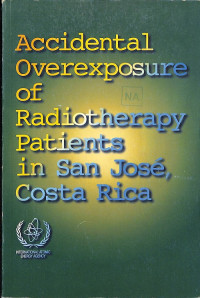Book
Accidental Overexposure of Radiotherapy Patients in San Jose, Costa Rica
Radiotherapy is well established as an indispensable means of treatment in national cancer control programmes in both developing and developed countries. In radiotherapy, radiation is used directly to destroy malignant tissue. The success of radiotherapy therefore depends on achieving a radiation dose that is high enough to kill malignant tissue yet sufficiently low to preserve to healthy tissue.This delicate balance is achieved by means of a carefully selected combination of treatment geometry and fractionated delivery of the dose for an optimal dose distribution within the body and over time.
Drawing up and disseminating the lessons to be learned from accidents are potentially extremely valuable for radiotherapy. The accident that occured in Costa Rica in 1996, with fatal consequences for some radiotherapy patients, is the first time that the IAEA has had the opportunity of evaluating the causes and consequences of severe overexposure in radiotherapy. A dosimetric evaluation was made and a medical data by an international medical team. (Jml)
Ketersediaan
Informasi Detail
- Judul Seri
-
-
- No. Panggil
-
615.8 IAE a
- Penerbit
- Vienna : IAEA., 1998
- Deskripsi Fisik
-
176 p. : Illus. ; 24 cm
- Bahasa
-
English
- ISBN/ISSN
-
9201020988
- Klasifikasi
-
615.8
- Tipe Isi
-
-
- Tipe Media
-
-
- Tipe Pembawa
-
-
- Edisi
-
-
- Subjek
- Info Detail Spesifik
-
Dokumen IAEA
- Pernyataan Tanggungjawab
-
-
Versi lain/terkait
| Judul | Edisi | Bahasa |
|---|---|---|
| Practice-Specific Model Regulations: Radiation Safety in Radiotherapy | - | en |
| Regulatory Guidance: Radiation Safety in Radiotherapy | - | en |
Lampiran Berkas
Komentar
Anda harus masuk sebelum memberikan komentar

 Karya Umum
Karya Umum  Filsafat
Filsafat  Agama
Agama  Ilmu-ilmu Sosial
Ilmu-ilmu Sosial  Bahasa
Bahasa  Ilmu-ilmu Murni
Ilmu-ilmu Murni  Ilmu-ilmu Terapan
Ilmu-ilmu Terapan  Kesenian, Hiburan, dan Olahraga
Kesenian, Hiburan, dan Olahraga  Kesusastraan
Kesusastraan  Geografi dan Sejarah
Geografi dan Sejarah